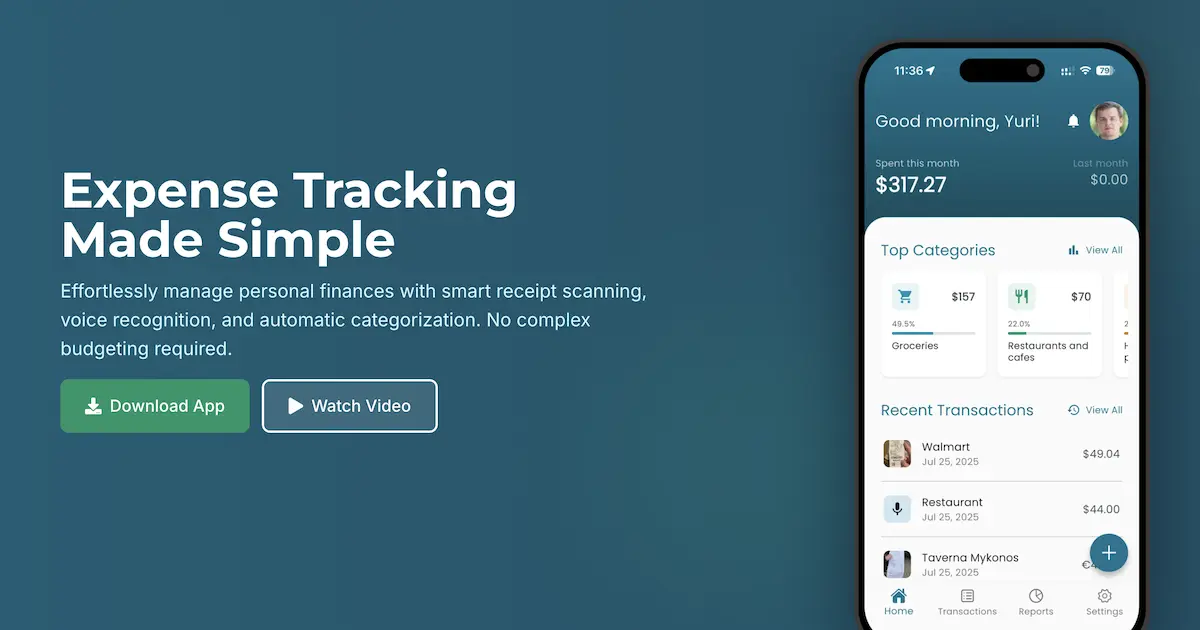Receiptix vs. YNAB: Which Expense Tracker Is Right for You?

Managing your personal finances doesn’t have to be overwhelming. Whether you’re trying to break the paycheck-to-paycheck cycle or gain better control over your spending, the right expense tracking app can make all the difference. If you’re new to expense tracking, our guide on From Confusion to Clarity can help you get started. In this post, we’ll compare two popular tools: Receiptix, an AI-powered expense tracker perfect for beginners, and YNAB (You Need A Budget), a robust budgeting platform.
Both apps aim to simplify money management but cater to slightly different needs. Let’s dive into the details so you can decide which one suits your lifestyle better.
Simplicity of Use: Getting Started Quickly
Receiptix
Receiptix is designed with beginners in mind. Its intuitive interface and AI-powered tools make it effortless to log expenses. You can snap a picture of a receipt, and the app automatically extracts and categorizes the details for you. Alternatively, you can log expenses by simply speaking into your device, thanks to its voice mode expense logging.
- Best for: Anyone who prefers a hands-off, straightforward way to track expenses without diving into complex budget systems.
- Why it stands out: Smart Categorization accurately predicts categories based on transaction details, minimizing manual corrections.
YNAB
YNAB requires users to actively create and manage budgets based on their income and financial goals. While the app offers comprehensive tutorials, its method — assigning every dollar a job — may feel overwhelming for newcomers to personal finance.
- Best for: Those who enjoy detailed budgeting and want to proactively assign their money to specific categories.
- Why it stands out: It focuses heavily on teaching users to build better financial habits.
Verdict: If you’re new to expense tracking, Receiptix’s beginner-friendly interface makes it easier to get started. YNAB’s structured system is ideal for more hands-on budgeters.
Tracking Expenses: A Detailed Look
Receiptix
Receiptix excels in item-level expense tracking, capturing individual items on a receipt rather than just the total purchase amount. This level of detail is incredibly useful for tracking specific spending habits, like how much you’re spending on groceries versus dining out. Want to learn more about how AI makes this possible? Check out our post on How AI Turns Your Spending Data into Actionable Advice.
- Key Feature: Multi-currency support makes Receiptix an excellent companion for frequent travelers.
- Time-saving tools: Automatic receipt scanning and voice input make tracking effortless.
YNAB
YNAB focuses on broader budgeting categories. While you can manually input expenses and split transactions, it doesn’t offer automated receipt scanning or item-level detail. You need to be disciplined about updating your budget regularly to get the most out of the app.
- Key Feature: Real-time syncing allows you to share budgets and track spending with partners or family.
Verdict: Receiptix’s automation tools and item-level tracking are better suited for those who want detailed insights with minimal effort. YNAB is great for those who prioritize budgeting over tracking granular details.
Insights and Visualizations: Understanding Your Spending Habits
Receiptix
Receiptix offers clear, intuitive charts and graphs that help users understand their spending habits at a glance. By focusing on visual insights, the app simplifies financial analysis, making it accessible even for users without a background in personal finance. Learn more about making data-driven financial decisions in our guide to Using Your Spending Insights to Save Money.
- Best for: People who want actionable insights without wading through data.
YNAB
YNAB also provides reports, but the focus is more on tracking progress toward financial goals rather than analyzing past spending patterns. Its emphasis on forward planning makes it a great tool for those who are actively working to save or pay down debt.
- Best for: Budgeters who want to track progress and improve cash flow management.
Verdict: If you prefer seeing where your money goes in an easy-to-digest format, Receiptix is the winner. YNAB shines for goal-focused financial planning.
Flexibility and Accessibility
Receiptix
Receiptix adapts to your lifestyle with features like customizable settings (dark mode, language preferences, etc.) and effortless data export for more advanced analysis. The app also supports multiple currencies, making it ideal for travelers or expats.
YNAB
YNAB’s system is built around its specific budgeting philosophy. While it’s flexible in how you allocate funds, users are expected to follow the app’s framework. This can be a strength for those who thrive with structure but may feel restrictive to others.
Verdict: For users who want flexibility and customization, Receiptix offers more ways to tailor the experience. YNAB’s structured approach is better for those who value consistency and discipline.
Pricing: What’s the Cost?
Both Receiptix and YNAB offer subscription-based pricing, but the details differ. Receiptix is generally positioned as a more affordable option, particularly for users who don’t need extensive budgeting features. YNAB, on the other hand, charges a premium for its comprehensive budgeting tools.
Which Should You Choose?
The best app for you depends on your financial goals and personal preferences. If you’re managing finances with a partner, you might want to check out our guide on Expense Tracking for Couples.
- Choose Receiptix if:
- You’re new to personal finance and want a simple, automated way to track spending.
- You value detailed insights without having to manually input data.
- You’re a frequent traveler or need multi-currency support.
- Choose YNAB if:
- You want to take control of your money with a detailed, hands-on budgeting system.
- You’re willing to invest time learning the app’s methodology.
At the end of the day, the right choice depends on your financial needs and preferences. Both apps offer unique strengths - whether you prioritize automated expense tracking or detailed budgeting methodology. Take time to evaluate your goals and try out the features that matter most to you before making your decision.
Note: This blog post is for informational purposes only and does not constitute financial advice. Always consult with a financial advisor for personalized guidance.